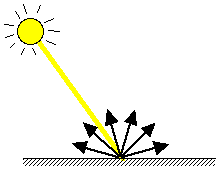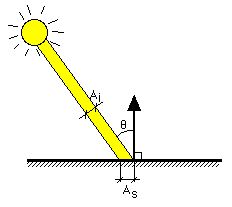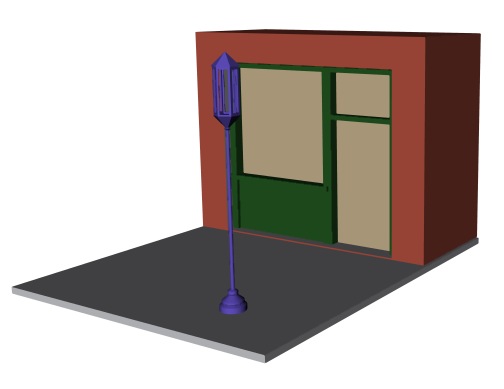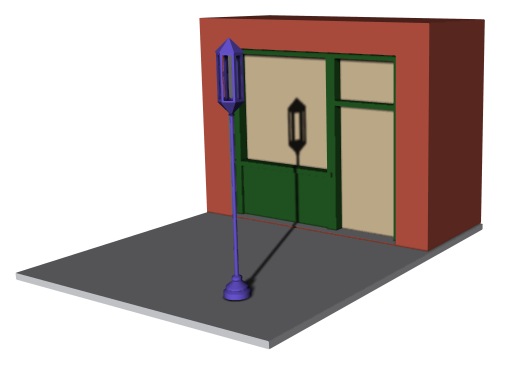TAPESTRY: The Art of Representation and Abstraction
SHADING:
Flat (aka Lambertian, Cosine or Uniform) Shading
The Dance of Light Upon Surface
What's it all about?

This is the simplest depiction of the way light interacts with a surface and a viewer, depending simply on the surface's orientation. It is based on the assumption that light is reflected uniformly in all directions (i.e., that the surface is a diffuse reflector). This might be diagrammed as shown at right, where we see a beam of light falling on the surface and being reflected evenly in all directions.
In this situation it doesn't matter where the observer is, because the light is reflected uniformly in all directions. What you see depends solely on the relationship between the surface and the light source(s).
 The relationship between orientation and the intensity of what we see is derived from the diagram at left. When a beam of light, described by the cross-sectional area Ai, strikes a surface, it is spread out over an area on the surface, As. This area is equal to Ai, only when the angle of incidence (theta), is zero. For angles of incidence greater than zero, the equation which describes the area of the surface covered by the beam is
The relationship between orientation and the intensity of what we see is derived from the diagram at left. When a beam of light, described by the cross-sectional area Ai, strikes a surface, it is spread out over an area on the surface, As. This area is equal to Ai, only when the angle of incidence (theta), is zero. For angles of incidence greater than zero, the equation which describes the area of the surface covered by the beam is

Note that this makes intuitive sense as well. When the light shines directly on the surface, we see a brighter reflection than when it strikes the surface at an angle, appproaching zero at 90 degrees.
Because the total incident light energy is distributed over a larger area, the viewer perceives a lower intensity reflection from the surface as theta increases. That is, the perceived intensity is inversely related to the area of incidence:

Shifting focus from area to perceived intensity, and including a factor (ks) for surface color in this calculation, we arrive at Lambert's Law:

When joined to an ambient term, we have an equation suitable for simple shading calculations:

This fundamental equation is central to most rendering algorithms. What will vary is the range (the amount of geometry) over which a single calculation is applied. If the light source is infinitely far away, the angle of incidence (theta) will be uniform across a given polygon and need only be calculated once for the polygon. For light sources within the model volume, it may have to be calculated much more frequently.
Sample
The image at left illustrates a scene rendered with only simple cosine shading (one distant light). Ambient light has been suppressed, which makes it render more stark, high-contrast. Compare it to the image at right, in which 10% ambient light is included (as are shadows).


Last updated: October, 2014
